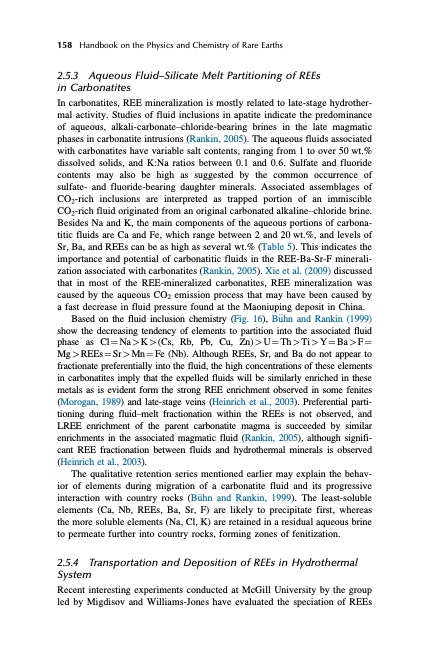
PDF Publication Title:
Text from PDF Page: 194
158 Handbook on the Physics and Chemistry of Rare Earths 2.5.3 Aqueous Fluid–Silicate Melt Partitioning of REEs in Carbonatites In carbonatites, REE mineralization is mostly related to late-stage hydrother- mal activity. Studies of fluid inclusions in apatite indicate the predominance of aqueous, alkali-carbonate–chloride-bearing brines in the late magmatic phases in carbonatite intrusions (Rankin, 2005). The aqueous fluids associated with carbonatites have variable salt contents, ranging from 1 to over 50 wt.% dissolved solids, and K:Na ratios between 0.1 and 0.6. Sulfate and fluoride contents may also be high as suggested by the common occurrence of sulfate- and fluoride-bearing daughter minerals. Associated assemblages of CO2-rich inclusions are interpreted as trapped portion of an immiscible CO2-rich fluid originated from an original carbonated alkaline–chloride brine. Besides Na and K, the main components of the aqueous portions of carbona- titic fluids are Ca and Fe, which range between 2 and 20 wt.%, and levels of Sr, Ba, and REEs can be as high as several wt.% (Table 5). This indicates the importance and potential of carbonatitic fluids in the REE-Ba-Sr-F minerali- zation associated with carbonatites (Rankin, 2005). Xie et al. (2009) discussed that in most of the REE-mineralized carbonatites, REE mineralization was caused by the aqueous CO2 emission process that may have been caused by a fast decrease in fluid pressure found at the Maoniuping deposit in China. Based on the fluid inclusion chemistry (Fig. 16), B€uhn and Rankin (1999) show the decreasing tendency of elements to partition into the associated fluid phase as Cl1⁄4Na>K>(Cs, Rb, Pb, Cu, Zn)>U1⁄4Th>Ti>Y1⁄4Ba>F1⁄4 Mg>REEs1⁄4Sr>Mn1⁄4Fe (Nb). Although REEs, Sr, and Ba do not appear to fractionate preferentially into the fluid, the high concentrations of these elements in carbonatites imply that the expelled fluids will be similarly enriched in these metals as is evident form the strong REE enrichment observed in some fenites (Morogan, 1989) and late-stage veins (Heinrich et al., 2003). Preferential parti- tioning during fluid–melt fractionation within the REEs is not observed, and LREE enrichment of the parent carbonatite magma is succeeded by similar enrichments in the associated magmatic fluid (Rankin, 2005), although signifi- cant REE fractionation between fluids and hydrothermal minerals is observed (Heinrich et al., 2003). The qualitative retention series mentioned earlier may explain the behav- ior of elements during migration of a carbonatite fluid and its progressive interaction with country rocks (B€uhn and Rankin, 1999). The least-soluble elements (Ca, Nb, REEs, Ba, Sr, F) are likely to precipitate first, whereas the more soluble elements (Na, Cl, K) are retained in a residual aqueous brine to permeate further into country rocks, forming zones of fenitization. 2.5.4 Transportation and Deposition of REEs in Hydrothermal System Recent interesting experiments conducted at McGill University by the group led by Migdisov and Williams-Jones have evaluated the speciation of REEsPDF Image | HANDBOOK ON THE PHYSICS AND CHEMISTRY OF RARE EARTHS

PDF Search Title:
HANDBOOK ON THE PHYSICS AND CHEMISTRY OF RARE EARTHSOriginal File Name Searched:
Chemistry-Rare-Earths-49.pdfDIY PDF Search: Google It | Yahoo | Bing
Sulfur Deposition on Carbon Nanofibers using Supercritical CO2 Sulfur Deposition on Carbon Nanofibers using Supercritical CO2. Gamma sulfur also known as mother of pearl sulfur and nacreous sulfur... More Info
CO2 Organic Rankine Cycle Experimenter Platform The supercritical CO2 phase change system is both a heat pump and organic rankine cycle which can be used for those purposes and as a supercritical extractor for advanced subcritical and supercritical extraction technology. Uses include producing nanoparticles, precious metal CO2 extraction, lithium battery recycling, and other applications... More Info
| CONTACT TEL: 608-238-6001 Email: greg@infinityturbine.com | RSS | AMP |